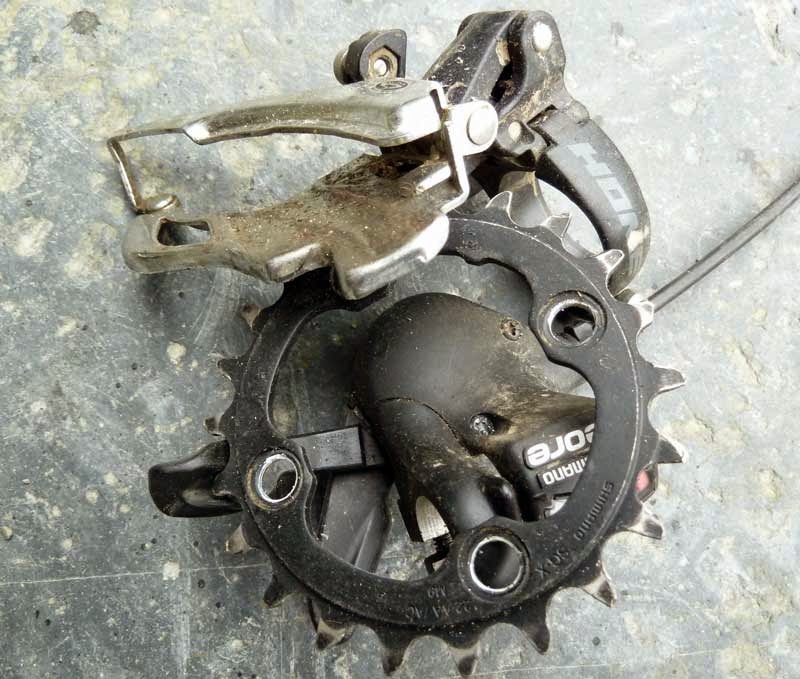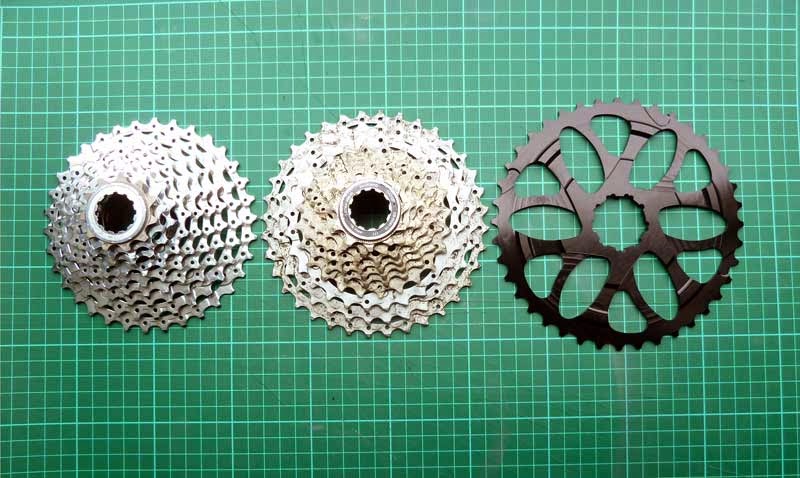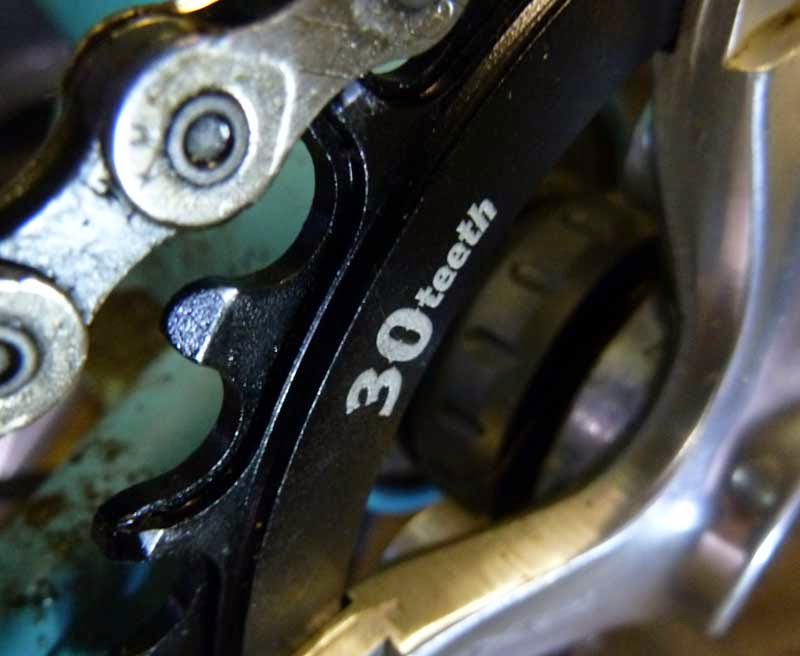Ever since gears were first fitted to the bicycle we’ve wanted more … 3 speed, 6 speed, 7 speed, 8 speed, 9 speed MORE. We haven’t craved knee straining, vain popping ‘big’ gears, we’ve wanted it easy. Gears that can seemingly transport us up the steepest of hills with the very minimum of physical effort, something we can sit and twiddle.
Anyone who rides singlespeed will tell you that gears are the work of the Devil and whenever you make a deal with Satan, there’s always a price to pay. In this case that price is complexity, 3 chainrings, 2 shifters, 9 cogs and 2 derailleurs is quite a lot of hardware and if it’s allied to the same level of mechanical ineptitude displayed by your average primate, then things are going to get messy sooner or later.
Oddly, it was the introduction of more gears that started a shift in thinking (or maybe a think in shifting?) … When 10 speed cassettes came along with their big shiny 36t sprockets, the brave took that as a cue to start removing bits. First to go was the big front ring, after all, they probably didn’t use it and it’s easier to set a front mech’ to work over 2 rings rather than 3 even if you do have opposing thumb and forefinger. Some people did miss their big rings however, so the 32t front ring was replaced by a 36 or maybe 39 toothed one … much better, now they weren’t spinning like hamsters on the flat bits. This increase in teeth wasn’t without its drawbacks though, they now found a large, ugly gap between the 2 front rings … I know, throw some more teeth at the ‘granny’ that’ll sort it. 2, 4 or 6 extra teeth were duly added to granny and the ‘big ugly gap’ was reduced to a more manageable ‘small step’. A reasonable spread of gears is retained albeit with less low gears and fewer high gears and by removing the biggest ring, a full 90g has been slashed from the bikes previous 14kg bulk.
 |
| You’d think they were responsible for the demise of the human race. |
The very, very bravest or those who live where it’s flat, bypassed the above, they took a deep breath and dived straight into ‘one ring up front’. 32 teeth at the pointy end, coupled with 36 on the rear would give a decent range of gears that could cope with the majority of situations. This system has a lot going for it, unlike the above 2 rings with more teeth scenario, going to a single ring does actually remove some noticeable parts and simplify things. A lowest gear ratio of 0.88:1 is pretty easy on the legs but obviously nowhere near as easy as having a 22t granny ring, a 22t in combination with a 36t cassette will produce a ratio of 0.61:1 … If you’re the type of rider who spends half their time with their chain firmly on the smallest ring, then you might want to stick with it.
If you’re still 1x curious, then I’d suggest setting your bike up 32 x 36 (or 34) and trying it. If you find that a couple of hours on an unloaded bike has you huffin’, puffin’ and gurning like an all England champion, then I’d walk away right now … “Yes, but there’s things I can add that’ll make it easier” – that’s right, there are but not that much easier. “If I keep doing it, I’ll get used to it” – I suppose you can get used to anything given enough time, you might even get used to having your testicles nailed to a table but most people are going to give up long before it becomes ‘easier’. Contrarily, if you tried it and found it okay, then there are a few things you can do to compensate for the added burden of luggage and long days containing big hills.
Making things easier.
For as long as mountain bikes have been running 104mm bcd crank arms, we’ve been limited to 32t ‘middle’ rings … which is weird because when the interest in 1 x started to grow, some manufacturers suddenly decided that we could in fact fit 30t rings to our 104mm cranks. This latest generation of chainrings are also designed with a tooth profile designed to help keep the chain on the ring rather than jammed between your crank and chainstays … a job that used to be taken care of by your front mech’. Switching from 32t to 30t will make a difference but not a massive one and you’ll need to bear in mind that it will affect each and every gear, your high gear will become lower, meaning you’re more likely to find yourself ‘spinning out’ on the flat bits.
 |
| 34, 36 and 40 teeth |
If a 2 tooth reduction on the front isn’t giving you the low gear you desire or you’re not willing to sacrifice what little top speed you have, you’re next option is a ‘range extender’. These chaps fit behind your cassette and give you a modern day equivalent of the old Shimano Mega-Range cassettes … basically, a very low ‘bail out’ gear. The plus side to fitting one, is that your other gear ratios remain unchanged but the flip-side is that you have to remove one of the other sprockets from the cassette in order to make room for it. Whether the removal of one of your smaller sprockets (usually 17t) is an issue will be down to you but it does produce quite a noticeable step between 15t and 19t. Depending on which manufacturer you’ve plumped for, you’ll be able to add either a 40t or 42t dinner plate to the back. If we assume you’ve gone the whole hog, then your 30t front and 42t rear will give you a ratio of 0.71:1 … still not quite 22t granny ring territory but closer than you were, in gear/inch terms it’s 20 compared to 17.6.
 |
| Just in case you forget. |
Or more expensive.
For anyone who’s smitten with the 1 x idea and feels they want to do things ‘properly’, there’s always the option of SRAM X01 or the wallet crippling X11. As you can no doubt guess from the names, they’re 11 speed, single ring specific groupsets primarily designed for those with deep pockets. The cassette contains sprockets ranging in size from 10 to 42, so you gain a little ‘top end’ over our ‘home brewed cobble together’ affair but the SRAM system can be run with a smaller chainring than our 30t … so you potentially get a lower gear than can be achieved otherwise. However, you need to remember that a 28t (you can go as low as 26t with aftermarket parts) ring will lower your gearing across the entire range. The result of 28/42 is a low gear ratio of 0.66:1 or 19.4 gear/inches in old money but the reduction in teeth from 30 to 28 does partly negate the high gear benefits of the smallest 10t sprocket.
 |
| SRAM X11 … use your imagination, we couldn’t actually afford to photograph one. |
Note: Gear/inches quoted for a 29er running 2.2″ tyres.

You forgot the 2×1 and 3×1 options 😉
Hmmm…. have to disagree with your "primarily made for those with deep pockets" comment. Whilst X11was hideously expensive when it was introduced it has since halved in price, plus the technology has filtered down to the slightly cheaper X01 and X1.
I say technology because the SRAM approach is much more than simply removing front rings and adding a rear. The derailleur system was never designed to handle the sort of terrain that today's mountain bikers throw at it and SRAM should be applauded for this new approach which really was the first proper look (from a mtb perspective) at the derailleur system since it's introduction nearly 100 years ago.
Firstly by having a single ring up front they were able to use their thick/thin chain ring design. This was actually developed many years earlier for DH bikes but was no good for regular mountain bikes as with a 2 or 3 ring set-up you need a chainring designed to help the chain come off whereas thick/thin is designed to keep it on, with its higher tooth profile and alternating tooth thickness.
They also approached the rear mech differently. Traditional mechs travel in a diagonal direction, moving side-to-side to change ratios and for-and-aft to keep the top jockey wheel close to the cassette. This means that when they bounce (over rough terrain) and the chain is deflected if four directions causing many dropped chains despite a front mech, which is designed to shift the chain and not necessarily to hold it in place. SRAM's solution is to have the rear mech moving in a single side-to-side plane, which they call X-Horizon, this eliminates any bounce from the mechanism. The requirement to keep the jockey wheels close to the cassette is solved by pivoting the cage closer to midway along it's length rather than around the top jockey wheel.
It's true that SRAM couldn't release this system whilst we were all riding triple rings as 3x gives 14 effective ratios (despite having 27/30 gear) and it would have been seen as a limiting, retrograde step. But as soon as 2x became popular, reducing effective ratios to 11 then the path was paved for X11.
Sorry if all that sounds like I'm a SRAM employee. I'm not, I just think they've looked at it properly rather than evolving a flawed design. I'm also quite happy to wax lyrical about the Pinion P1 gearbox. Another time maybe!
As for the general subject of 1x, yes we are all different. Personally 1×10 with a 30 front and standard 11/36 is enough for me (I'm switching to 11 for the tech, not necessarily the extra gear). Without referring to specific ratios, when I went 1×10, I effectively lost my bottom two gears, which was a concern mentally but in reality I've hardly missed them and definitely adopted a must-try-harder approach when looking down and noticing I was in my lowest gear whereas before I would just have changed down for an easier life. I also lost my top gear, which I'm not sure I ever used anyway.
By far the biggest advantage to me is less clutter on the bike/bars and zero dropped chains since switching. The weight saving? Not too fussed. I have theories that rider weight, geometry and bike fit need to be sorted before too much attention is paid to bike weight.
McGroo.
Thanks for the input McGroo. Please don't think I was 'having a go' at 1 x 10 or whatever, the piece was an attempt to get anyone considering a swap to think about it a little before they do. I run 1 x 10 on a couple of bikes and 95% of the time find the range of gears adequate but I know there will be people, who for whatever reason will struggle … but who might be tempted to try it, simply because it seems to be the thing to do.
I can't fault SRAM and their engineering … have you considered applying for a job with their PR department? ;o)
They wouldn't have me, I'd be far too critical of their brakes and dropper posts!